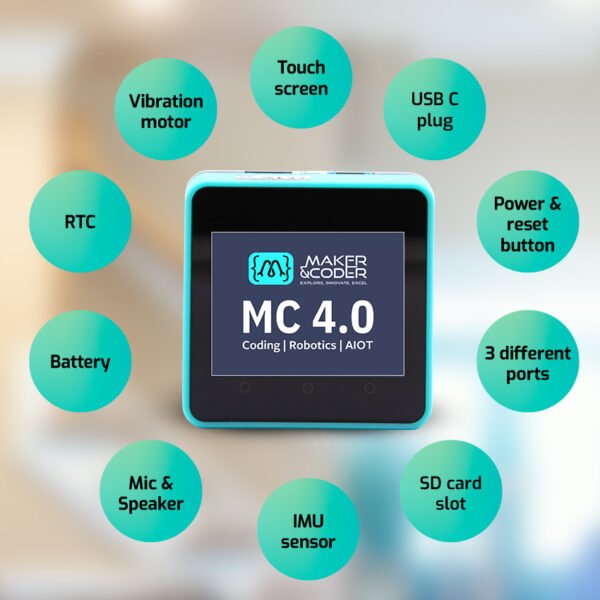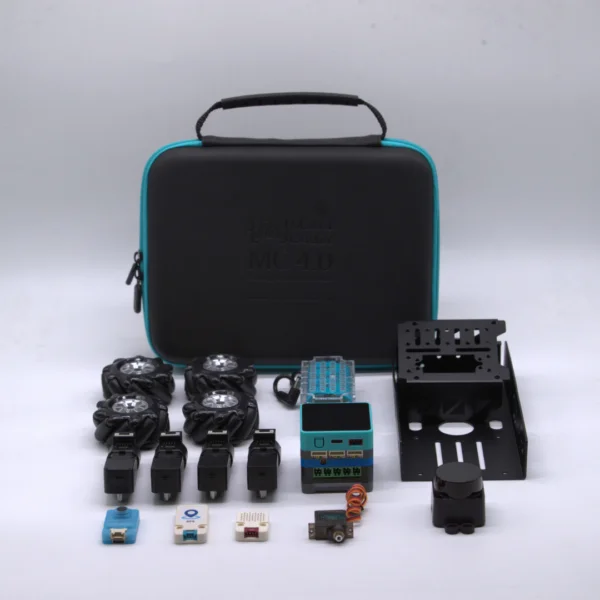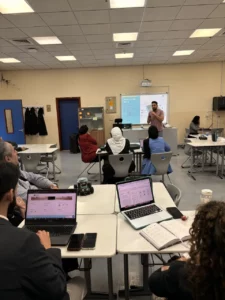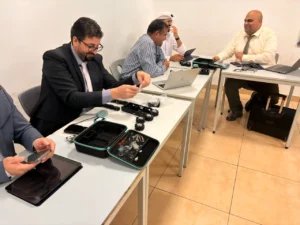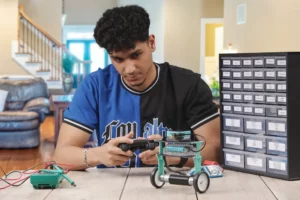Introduction to AIoT Technology in Education
AIoT in education refers to the integration of Artificial Intelligence (AI) and Internet of Things (IoT) technologies to enhance the learning experience. It involves leveraging AI to analyze data and IoT to connect devices and systems for efficient and personalized education. By using AIoT, educators can create personalized learning paths, provide real-time feedback, and adapt teaching methods based on students’ individual needs. Similarly, IoT devices can automate administrative tasks, improve safety and security, and create interactive learning environments. The integration of AIoT in education aims to prepare students for future careers by providing them with essential technological skills and knowledge.

The Role of AIoT in Modern Learning
AIoT, or Artificial Intelligence of Things, plays a critical role in modern learning. AIoT technology integrates artificial intelligence with the Internet of Things devices, such as smart sensors and cameras, to enhance the learning experience. Here are a few ways AIoT is revolutionizing modern learning:
- Personalized Learning: AIoT technology can analyze students’ learning patterns and customize learning experiences to suit their individual needs, helping them grasp concepts more efficiently.
- Enhanced Security: With AIoT, schools can ensure the safety and security of students through intelligent surveillance and monitoring systems, contributing to a more secure learning environment.
- Efficient Resource Management: AIoT enables schools to optimize resource usage, such as energy or classroom space, by providing real-time data and insights for better decision-making.
- Interactive Learning: Through AIoT, students can engage in more interactive and immersive learning experiences, fostering a deeper understanding and retention of knowledge.
AIoT is paving the way for a more dynamic, efficient, and tailored learning experience for students, preparing them for success in an increasingly digital and interconnected world.
Benefits of Integrating AIoT into Education
Integrating AIoT into education provides several benefits for preparing students for success:
- Enhances personalized learning experiences tailored to individual student needs.
- Encourages interactive and engaging learning activities, making education more enjoyable for students.
- Facilitates real-time tracking and analysis of student performance to identify areas of improvement.
- Prepares students for the future job market by familiarizing them with AI and IoT technologies.
- Increases efficiency in administrative tasks, allowing educators to focus more on teaching and mentoring students.
Customized Learning Experiences with AIoT
In a customized learning experience with AIoT, students can have personalized lessons tailored to their unique learning styles and abilities. AIoT technology enables the creation of individualized learning paths, interactive activities, and adaptive assessments based on each student’s progress and challenges. This can result in more effective learning, increased engagement, and better academic outcomes for students.
AIoT and Student Engagement
Artificial Intelligence of Things (AIoT) can significantly enhance student engagement by providing personalized learning experiences. By analyzing students’ behavior and preferences, AIoT can tailor educational content to their individual needs, helping to maintain their interest and motivation. This technology also enables real-time feedback on students’ progress, allowing educators to identify and address challenges promptly. Additionally, AIoT can facilitate interactive learning through virtual simulations and immersive experiences, making the learning process more engaging and effective.
AIoT in Teacher Support and Classroom Management
AIoT technology, a combination of Artificial Intelligence (AI) and the Internet of Things (IoT), is revolutionizing teacher support and classroom management. Here’s how it works:
- AIoT can help teachers analyze student performance data in real-time, allowing for personalized support and intervention.
- It enables automated attendance tracking, behavior monitoring, and classroom safety measures, contributing to efficient classroom management.
- The integration of AIoT devices and software can streamline administrative tasks, freeing up teachers to focus on personalized instruction and student engagement.
AIoT technology has the potential to transform the way teachers support their students and manage their classrooms.Enhancing Curriculum with AIoT Technology
Adding AIoT technology to the curriculum paves the way for a more interactive and engaging learning environment. Through AIoT, students can gain practical experience by working with real-time data and devices, promoting a deeper understanding of complex concepts. In addition, integrating AIoT into the curriculum can help students develop essential skills such as problem-solving, critical thinking, and collaboration, which are crucial for their future success. By incorporating AIoT technology, the curriculum becomes more relevant and adaptable to the rapidly evolving technological landscape, preparing students for the real-world challenges they will face in their careers.
Challenges and Considerations in Implementing AIoT in Education
Implementing AIoT in education presents several challenges that need to be carefully considered:
- Infrastructure: Educational institutions must ensure that their infrastructure can support the integration of AIoT technology, including reliable internet connections and compatible devices.
- Privacy and Security: Protecting student data and ensuring privacy is a top concern when implementing AIoT in education. Safeguards must be put in place to prevent unauthorized access to sensitive information.
- Training and Support: Educators and staff will need adequate training to effectively utilize AIoT technology in the classroom. Ongoing support and professional development opportunities are essential for successful implementation.
- Equity and Access: Ensuring that all students have equal access to AIoT technology is crucial. Addressing potential disparities in technology access and skills is important for creating an inclusive learning environment.
These considerations are essential for the successful integration of AIoT in education, and addressing these challenges will be paramount for preparing students for success in the future.
Ethical and Privacy Concerns with AIoT in Education
AIoT technology in education raises ethical and privacy concerns due to the extensive collection of student data. This includes information about students’ behavior, academic performance, and personal details. Some concerns include:
- Data Security: The potential for student data to be vulnerable to breaches and unauthorized access.
- Privacy: The possibility of students’ personal information being used without their consent.
- Bias and Discrimination: How AI algorithms might perpetuate biases in the education system.
- Transparency: The need for transparency in how student data is collected, used, and shared.
The Future of Learning: AIoT Technology in Education
AIoT, which stands for Artificial Intelligence of Things, is an innovative technology that combines artificial intelligence with the Internet of Things to enhance the learning experience. With AIoT technology, educators can personalize the learning process for students, provide real-time feedback, and create an interactive and dynamic environment. This technology can also assist in identifying students’ strengths and weaknesses, allowing for more tailored, efficient, and effective teaching methods. Additionally, AIoT can facilitate seamless collaboration and communication among students and teachers, fostering a more connected and engaging learning environment.

